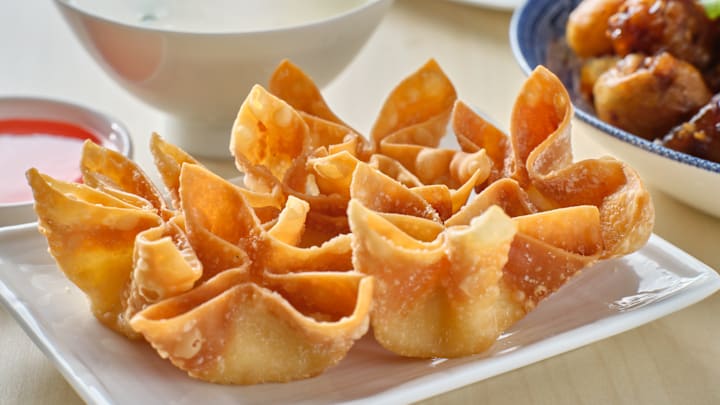Many Chinese dishes loved by Americans didn’t originate in China. Fortune cookies are a Japanese creation, and General Tso’s chicken was invented in Taiwan. One of the most perplexing Chinese-American restaurant staples is crab rangoon. This fried dumpling, which is stuffed with a sweet and creamy seafood filling, scarcely resembles anything from Hunan, Szechuan, Cantonese, or other Chinese cuisines. Even if they order it with their takeout, many customers have no idea what crab rangoon is or where it comes from.
Before it appeared on Chinese restaurant menus, crab rangoon was conceived for Trader Vic’s in the 1940s, Atlas Obscura reports. Victor Bergeron’s tiki bar chain sold a kitschy, westernized version of Polynesian culture to American customers. Signature items—like their Mai Tai cocktail—were meant to feel vaguely exotic, though they were wholly original inventions.
According to his granddaughter Eve, crab rangoon was the brainchild of Trader Vic’s founder Victor Bergeron. He was playing with wonton wrappers in the kitchen one day when he thought to stuff them with crab meat and cream cheese and deep fry them. The restaurant had a Chinese-American barback at the time named Joe Young. He was responsible for the Chinese-leaning menu, and he may have had an influence on crab rangoon.
Though the wonton wrappers were Chinese, any similarity to culture’s cuisine stopped there. Cream cheese was popular in American households in the 1940s, but it wasn’t used in China: The majority of the country is lactose intolerant, and its cuisine is virtually dairy-free. To confuse the dish’s identity even further, Vic named it crab rangoon after the former name of the city of Yangon in Myanmar.
Despite its odd mash-up of cultures, Trader Vic’s crab rangoon was a success. Independent Chinese-American restaurants began making their own versions, and as the chain became less popular throughout the 20th century, the appetizer lived on. The fried wontons you order from your local Chinese place today are likely similar to those served by Trader Vic’s in the 1940s and ‘50s. The most common difference is the crab, which modern restaurants often swap for imitation crab to cut down on costs. If you don’t know what imitation crab is, that’s its own slightly unappetizing story.
[h/t Atlas Obscura]
